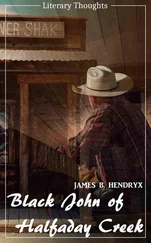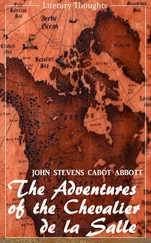Our Iroquois, being tired with the day's journey and longing for a fair wind to ease their arms, frequently in the course of the afternoon, scattered a little water from the blades of their paddles as an offering to La Vieille, who presides over the winds. The Canadian voyagers, ever ready to adopt the Indian superstitions, often resort to the same practice, though it is probable that they give only partial credence to it. Formerly the English shipmen, on their way to the White Sea, landed regularly in Lapland to purchase a wind from the witches residing near North Cape; and the rudeness and fears of Frobisher's companions in plucking off the boots or trowsers of a poor old Eskimo woman on the Labrador coast, to see if her feet were cloven, will be remembered by readers of arctic voyages.
Throughout the day's voyage, the primitive formation continued. In several places we observed micaceous slate, traversed by large veins of granite, and alternating with beds of the same, also gneiss in thick beds, with its layers much contorted. Below the Great Rapid there are many bluff granite rocks, and some precipices thirty or forty feet high, the higher knolls rising probably from two to three hundred feet above the water. At the Great Rapid a greenstone-slate stained with iron occurs. At the Barrel Portage, a mile or two further on, where the river makes a sharp bend, beds of chlorite-slate occupy its channel for two miles, having a north-east and south-west strike, and a southerly dip of 60° or 70°. Beds of greenstone-slate are interleaved with it. Above the Island Portage a sienite occurs which contains an imbedded mineral; and at the Rapid River Portage, mica-slate, passing into gneiss, prevails, the beds having a south-west and north-east strike. The granite veins here have a general direction nearly coincident with that of the beds, but they are waved up and down. In the vicinity of the veins the layers of slate are much contorted, following the curvatures of the veins closely. At the lightening-place of the Rapid River, there is a fine precipice of granite fifty feet high, which is traversed obliquely from top to bottom by two magnificent veins of flesh-coloured porphyry-granite. Five miles further on there are precipices of granite one hundred and fifty feet high.
The country in this neighbourhood is hilly, and a few miles back from the river the summits of the eminences appear to the eye to rise four hundred or perhaps five hundred feet above the river. The resemblance of the whole district to Winipeg River is perfect, and the general aspect of the country is much like that of the north shores of Lake Superior, though the water basin is not so deeply excavated.
An hour and a half after starting on the morning of the 20th, we crossed the Mountain Portage, one hundred paces long, where the rock is hornblende-slate. At Little Rock Portage, a short way further on, the thin slaty beds have a north-east and south-west strike. Above this, a dilatation of the river, named Otter Lake, leads to the Otter Portage of three hundred paces made over mica-slate. The beach there is strewed with fragments of a crystalline augitic greenstone, showing that that rock is not far distant.
From a party of Chepewyans who were encamped on the Otter Lake, we procured a quantity of a small white root, about the thickness of a goose quill, which had an agreeable nutty flavour. I ascertained that it was the root of the Sium lineare. The poisonous roots of Cicuta virosa, maculata, and bulbifera, are often mistaken for the edible one, and have proved fatal to several labourers in the Company's service. The natives distinguish the proper kind by the last year's stem, which has the rays of its umbel ribbed or angled, while the Cicutæ have round and smooth flower-stalks. When the plant has put out its leaves, by which it is most easily identified, the roots lose their crispness and become woody. The edible root is named ūskotask by the Crees, and queue de rat by the Canadians. The poisonous kinds are called manito-skatask, and by the voyagers carrotte de Moreau, after a man who died from eating them.
The Heuchera Richardsonii, which abounds on the rocks of this river, is one of the native medicines, its astringent root being chewed and applied as a vulnerary to wounds and sores. Its Cree name is pichē quaow-utchēpi. The leaves of the Ledum palustre are also chewed and applied to burns, which are said to heal rapidly under its influence. The cake of chewed leaves is left adhering to the sore until it falls off.
In the course of the forenoon we ascended four rapids, occasioning short portages, then the Great Devil's Portage, of fourteen hundred paces; and in the afternoon several other rapids were passed, among which were the Steep Bank, Little Rock, and Trout portages. At the Steep Bank Portage (Portage des Ecores), which is one hundred and sixty paces long, gneiss and mica-slate occur interleaved irregularly with each other, and intersected in every direction by reticulating quartz veins; the prevailing rock in the neighbourhood being gneiss, and the hills low and barren.
June 21st.—Soon after starting we crossed the Thicket Portage (Portage des Haliers) of three hundred and sixty paces, and entered Black-bear Islands Lake, a very irregular piece of water, intersected by long promontories and clusters of islands. After four hours' paddling therein we came to a rapid, considered by the guide as the middle of the lake; in three hours more we came to another strong rapid, and after another three hours to the Broken-Canoe Portage, which is at the upper end of this dilatation of the river. Granite is the prevailing rock in the lake, and one of the small islands consists of large balls of that stone, piled on each other like cannon shot in an arsenal. They might be taken for boulders were they not heaped up in a conical form and all of one kind of stone; and they have obviously received their present form by the softer parts of the rock having crumbled and fallen away. At Thicket Portage and the lower end of the lake, the granite is associated with greenstone slate; and at Broken-Canoe Portage, above the lake, a laminated stone exists, whose vertical layers are about an inch thick, and have a north and south strike, being parallel to the direction of the ridges of the rock. This stone is composed of flesh-coloured quartz, with thin layers of duck-green chlorite, and no felspar. It ought perhaps to be considered as a variety of gneiss.
Later in the afternoon we came to the Birch and Pin Portages, on the last of which we encamped. The granite rocks here are covered by a high bank of sand and gravel, filled with boulders.
June 22d.—Embarking early, we passed through Sand-fly Lake, and afterwards Serpent Lake, in which we met the Athabasca brigade of boats, under charge of Chief Trader Armitinger. This gentleman informed us that he met Mr. Bell with our boats on the 19th, on which day they would arrive at Isle à la Crosse. The aspect of the country changes suddenly on entering these lakes. The rising grounds have a more even outline, and one long low range rises over another, as the country recedes from the borders of the water, where it is generally low and swampy. The trees near the water are almost exclusively birch and balsam-poplar, or aspen; the spruce firs occupying the distant elevations, which are generally long round-backed hills, with a few short conical bluffs. Serpent Lake is named from the occurrence on its shores of a small snake. I was not able to learn that this or any other snake had been detected further to the north. Having passed a high sand-bank on the north side of Serpent Lake, six miles further on, we entered the Snake River, within the mouth of which there is a bank of loam, sand, and rolled stones, thirty-five feet high. The bed of the stream is lined with these stones, and its width is about equal to that of Rainy River. The rocky points, as seen from the canoe, appeared to be of granite. All the boulders that I examined were of a dull brownish-red, striped or laminated granite, which, on a cursory inspection, might be mistaken for sandstone. Boulders of the same kind occur at the Snake Rapid, where they are intermixed with a few pieces of hornblende rock.
Читать дальше












